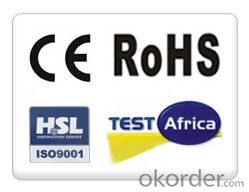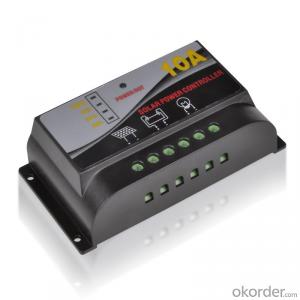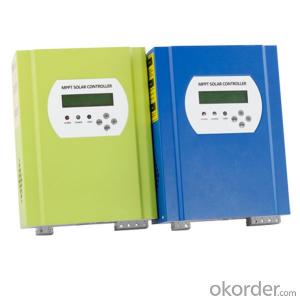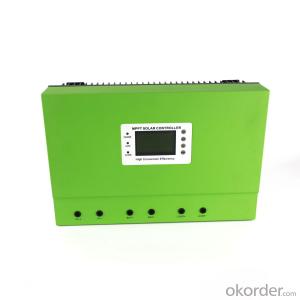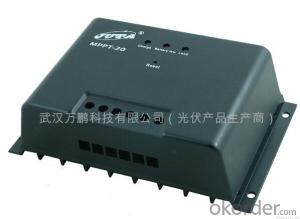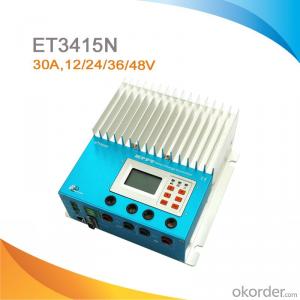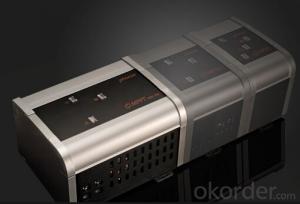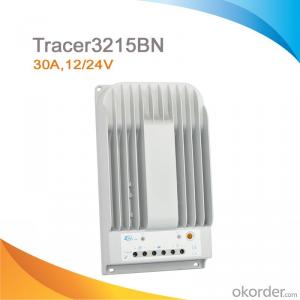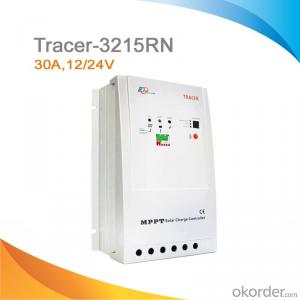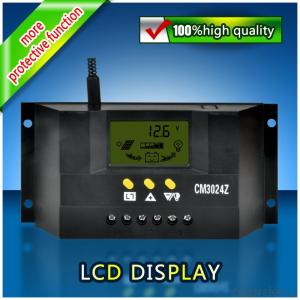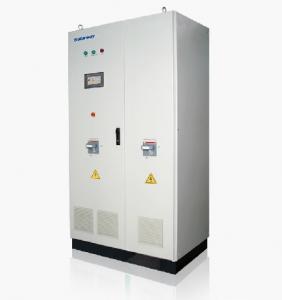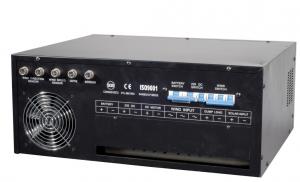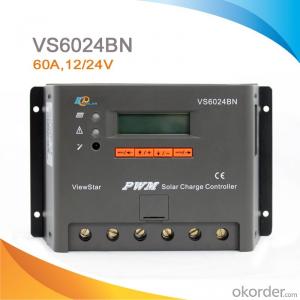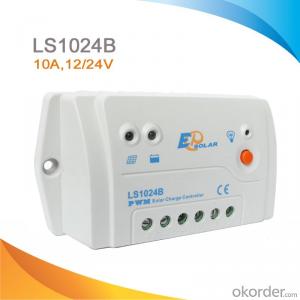Solar Controller for Tracking Maximum Power Model eMPPT 3024Z
- Loading Port:
- Shanghai
- Payment Terms:
- TT OR LC
- Min Order Qty:
- 5 unit
- Supply Capability:
- 30 unit/month
OKorder Service Pledge
OKorder Financial Service
You Might Also Like
1. Structure of Solar Controller for Tracking Maximum Power Model eMPPT 3024Z
The Solar Controller eMPPT 3024Z can be used in home system, and it benefits from DC/DC converter technique and MCU technique, which have capacity to adjust the operation spot of the solar modules so as to reach the maximum power output of the solar modules. The MCU of controller of Series eMPPT can intelligently track the operation spot of the solar modules by the algorithm MPPT, so the use ratio of solar modules can be raised and therefor the cost of the solar generating system can be reduced. Compare to the ordinary solar charging controller, eMPPT controller can in general increase the power output of the solar modules by 5% at least and 30% at most(the own characteristics of solar modules, temperature and illumination etc. have effect on how to raise the percentage of the power output ).
2. Main Features of Solar Controller for Tracking Maximum Power Model eMPPT 3024Z
Dot matrix large screen and LCD showing all parameters
Vivid icon indicating the concept of all parameters
Nice interface and clear for observation
Whole device for wall mounting type to install
3. Solar Controller for Tracking Maximum Power Model eMPPT 3024Z Images
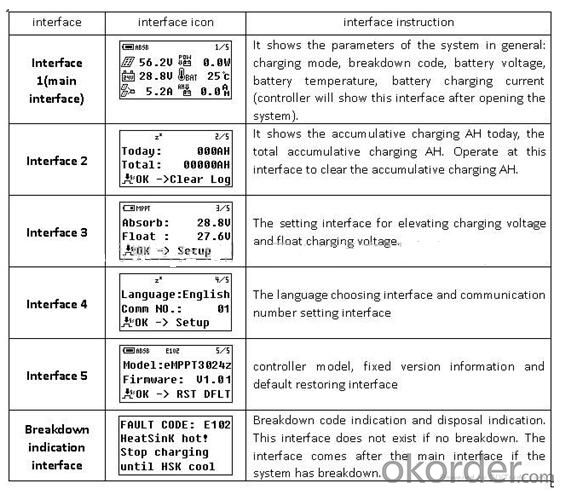
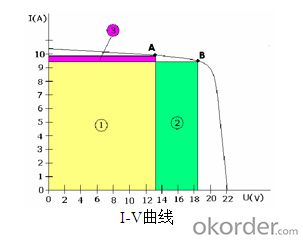
4. Solar Controller Model for Tracking Maximum Power eMPPT 3024Z Specification
Mode | eMPPT3024Z | |
Input | Solar Module Input Voltage Scope | ≤70V |
Maximum Power Spot Tracking Voltage Scope | 12V~70V(12V) | |
24V~70V(24V) | ||
Solar Module Input Circuit | Circuit 1 | |
Output | Rated Working Voltage | 12V/24V(Automatic Identification) |
Max. Charging Current | 30A | |
Stand-by loss | ≤30mA | |
Charging Mode | Three phases for charging control(Bulk、Absorption、Float) | |
Floating Charge Voltage | 27.6V(adjustable) | |
Temperature compensation for Floating Charge Voltage | -4mV/cell/℃ | |
Absorption Charging Voltage | 28.8V(adjustable) | |
Range of Temperature measurement | -20℃~+70℃ |
5. FAQ
We have organized several common questions for our clients, which may help you sincerely:
1) How to guarantee the quality of the products?
The company is approved by the ISO9000 quality management system with its strict product quality control. The products for exportation pass the inspection of relevant foreign nations (CE, ROHS), and get high evaluation of the customers.
2) How long can we receive the product after signing Sales Confirmation?
Generally speaking, if there is enough quantity of finished products which can meet the clients’ requirement, we can manage the delivery within three to five working days according to the instruction of the payment terms in the Sales Confirmation; if the products needs some time to get ready, we will arrange the delivery as soon as possible after the manufacture.
- Q: Can a solar controller be used with different types of solar panels (monocrystalline, polycrystalline, thin-film)?
- Yes, a solar controller can be used with different types of solar panels including monocrystalline, polycrystalline, and thin-film. The solar controller's main function is to regulate the charging process of the battery by monitoring the voltage and current from the solar panels. It is designed to work with various types of solar panels, making it compatible with different technologies and ensuring efficient charging regardless of the panel type.
- Q: Can a solar controller be used with solar panels of different materials?
- Yes, a solar controller can be used with solar panels of different materials. The function of a solar controller is to regulate the flow of energy from the solar panels to the battery or grid, regardless of the material used in the solar panels. The controller's purpose is to ensure optimal charging and prevent overcharging or damaging the battery, irrespective of the panel material.
- Q: How does a solar controller handle battery desulfation?
- A solar controller handles battery desulfation by periodically applying high voltage pulses to the battery, which helps break down and remove sulfation buildup on the battery plates. This process rejuvenates the battery and improves its overall performance and lifespan.
- Q: How does a solar controller handle load control for powering other devices?
- A solar controller handles load control for powering other devices by regulating the power flow from the solar panels to the devices. It monitors the battery voltage and adjusts the charging and discharging process accordingly to ensure that the connected devices receive the appropriate amount of power. This prevents overcharging or discharging of the battery and protects the devices from potential damage.
- Q: What is the maximum load current in standby mode of a solar controller?
- The maximum load current in standby mode of a solar controller typically depends on the specific model and its design specifications. However, the load current in standby mode is usually very minimal, often around a few milliamperes or even less. This low current ensures that the solar controller consumes minimal power while in standby, maximizing energy efficiency.
- Q: How does a solar controller prevent overvoltage in the battery?
- The battery's overvoltage is prevented by the solar controller, as it carefully monitors and regulates the charging process. When electricity is produced by the solar panel, it is directed to the battery for storage. However, if the voltage generated by the solar panel exceeds the battery's capacity, it can result in overcharging and damage to the battery. To avoid this, a solar controller acts as a mediator between the solar panel and the battery. It continuously monitors the battery's voltage level and ensures that it does not go beyond a specific predetermined limit. If the battery's voltage approaches or surpasses this limit, the solar controller will automatically decrease the charging current or disconnect the solar panel from the battery to prevent overvoltage. Solar controllers use various methods to regulate the charging process and prevent overvoltage. One commonly used technique is known as pulse-width modulation (PWM), where the controller swiftly switches the charging current on and off to maintain a consistent voltage level. Another method is called maximum power point tracking (MPPT), which optimizes the solar panel's output to match the voltage requirements of the battery. Furthermore, solar controllers perform other essential functions aside from preventing overvoltage. One example is temperature compensation, where the charging parameters are adjusted based on the battery's temperature. Another function is the low voltage disconnect, which safeguards the battery from deep discharge. By effectively managing the charging process, solar controllers ensure that the battery in a solar power system remains in optimal condition and performs at its best for a longer period of time.
- Q: Can a solar controller handle high temperatures?
- Yes, a solar controller can handle high temperatures. Solar controllers are designed to operate efficiently even in extreme heat conditions, ensuring the proper functioning and protection of the connected solar panels and batteries. They are equipped with thermal management systems and components that can withstand high temperatures without compromising their performance or longevity.
- Q: Can a solar controller be used with solar-powered disaster response equipment?
- Yes, a solar controller can be used with solar-powered disaster response equipment. A solar controller is essential in regulating and optimizing the charging process of solar panels, ensuring that the equipment's batteries receive the right amount of power and preventing overcharging or damage. By using a solar controller, disaster response equipment can effectively harness solar energy and operate efficiently during critical situations.
- Q: Can a solar controller be used with solar panels of different colors?
- Yes, a solar controller can be used with solar panels of different colors. The color of the solar panels does not affect the functionality of the solar controller, as it is designed to regulate the voltage and charge the batteries connected to the solar system, regardless of the color of the panels.
- Q: How does a solar controller handle battery under-temperature protection?
- A solar controller handles battery under-temperature protection by monitoring the temperature of the battery and adjusting the charging parameters accordingly. If the battery temperature drops below a certain threshold, the controller reduces the charging current to prevent damage to the battery. This helps to maintain the battery's performance and prolong its lifespan.
Send your message to us
Solar Controller for Tracking Maximum Power Model eMPPT 3024Z
- Loading Port:
- Shanghai
- Payment Terms:
- TT OR LC
- Min Order Qty:
- 5 unit
- Supply Capability:
- 30 unit/month
OKorder Service Pledge
OKorder Financial Service
Similar products
Hot products
Hot Searches
Related keywords



